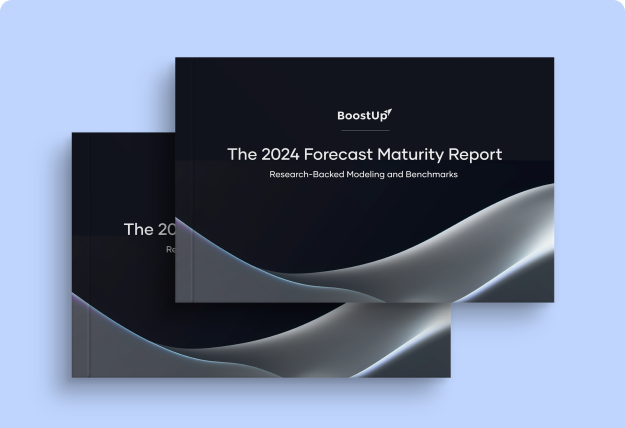The Revenue Blog /
How to Create Accurate Sales Forecasting Reports
How to Create Accurate Sales Forecasting Reports

Topics covered in this article
Reports are an effective leader's best friend as they ideally provide a complete picture of a process' status or team's performance at the touch of a button.
In addition to showing the big picture, an accurate sales forecasting tool has many other benefits - in this article we'll look at these and share some best practices for sales forecasting reports.
What is a "Sales Forecasting Report"?
One of the most exciting types of reports in the sales area is the forecasting report, which attempts to estimate the expected performance of a future period based on various data, a significant portion of which is the intuition and manual adjustments of sales reps.
For example, a sales forecast for the next financial year includes not only the value of deals still in progress but also future deals that may not even be in the first stage of the pipeline.
What are the goals of a sales forecast report?
A useful sales forecasting report is based on high-quality data, such as CRM inputs, historical performance, emails, notes, market news, and other variables. Good data quality and sufficiently diversified data inputs are important to prevent salespeople, who tend to be more optimistic about their own deals than reality, from manually adjusting their forecasts upwards.
While anyone can become an "Excel billionaire", management wants to avoid this situation by all means, because a good forecast report serves several purposes and is also used outside the sales department.
- It shows management the direction. Forecasted revenues are not only important for the sales team but for the entire company.
- They help with cash flow management. An important element of forecast reports is the cash flow approach, i.e. they not only show a specific total but also indicate the expected revenue periodically (weekly, monthly, quarterly).
- Guides sales leadership. With the help of data analytics technologies and AI available today, it is even easier for sales leadership to identify where the weak points are in the overall process and where they should intervene in the operation on an individual or business level.
Key components of an effective sales forecasting report
Now that we've clarified the objectives, let's look at the key elements of an effective sales forecasting report.
- A well-maintained CRM. It is of paramount importance that forecasting accuracy can only be increased or maintained at a high level if all data is available in the CRM and other relevant databases. The basis for a credible estimate of future sales performance is past performance, which is particularly important for lead times for a particular company or for estimating the performance of a particular salesperson.
- Ambitious but realistically defined future plans. A good plan for future revenue is both ambitious and realistic. An important part of the forecast is the current state of the business compared to the plan. Sales leadership can provide appropriate support on an individual or deal level based on the current status, which in turn requires good planning.
- An easily adaptable structure. In some industries, circumstances can change very quickly and sales reports should be able to track this. The key to this is not only predefined metrics but also the ability to set up custom metrics without the need for coding.
- Well-defined sales pipeline metrics. Good examples are the "Pipeline Coverage Ratio" (ratio of pipeline to quota), "Quota Attainment" (percent of quota achieved), "Slip Rate Trend" (deal closure delays), or "Pipe Gen Gap to Target" (shortfall to sales target).
- Supportive AI tools. Artificial intelligence can be used to pull together data from different sources while learning algorithms help to translate historical performance into future plans.
Common challenges and best practices in sales forecasting
When a company's sales department grows to the point where the number of deals is in the hundreds or even thousands, the sales forecast analysis and even the data management in itself become progressively more difficult. Salesforce and its competitors are the market leaders in data capture, but there are situations where the huge amount of data available is not fast enough and can only be managed successfully with other tools.
Furthermore, if you have multiple databases providing the information (CRM, various internal spreadsheets, call and email activity trackers, etc.), you need to use a tool like BoostUp to ensure efficient reporting. Not only does the BoostUp platform improve forecasting accuracy and pipeline hygiene, but well-designed dashboards make it easy to identify gaps where management needs to provide support.
Instead of coding-based business intelligence solutions, BoostUp provides a coding-free environment where customized reports can be easily compiled. And each sales opportunity contains all the information within one platform to see how the situation has evolved (e.g. last meeting, number of follow-ups, prospect engagement).
Another common challenge is managing complex corporate structures. When a company needs to map countless different deal types in one report and prepare the information for decision-making, it is important to have a solution that can support labor-intensive reporting.
If the analysis that forms the basis of reporting is done manually, not only is it expensive, slow, and prone to numerous errors, but it also tends to make it difficult to track changes in real-time.
The customized forecasting reports created in the BoostUp platform are not only suitable for processing a wide variety of data but can also provide greater transparency with maximum precision, even in the face of continuous change.
Check out our solution for creating accurate sales forecasting reports.



-Photoroom.png)